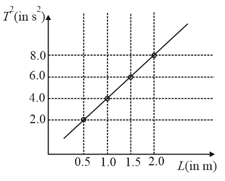EASY
Earn 100
In the following a statement of Assertion is followed by a statement of Reason.
Assertion: In damped oscillations, the oscillator experiences both conservative and non-conservative forces.
Reason: In damped oscillations mechanical energy of oscillator decreases with time.
(a)Both Assertion & Reason are true and the Reason is the correct explanation of the Assertion.
(b)Both Assertion & Reason are true but the Reason is not the correct explanation of the Assertion.
(c)Assertion is true statement but Reason is false.
(d)Both Assertion and Reason are false statements.
60% studentsanswered this correctly
Important Questions on Simple Harmonic Motion
EASY
MEDIUM
EASY

In an experiment to determine the gravitational acceleration of a place with the help of a simple pendulum, the measured time period squared is plotted against the string length of the pendulum in the figure. What is the value of at the place?
EASY
HARD
A pendulum with the time period of is losing energy due to damping. At a certain time, its energy is . If after completing oscillations its energy has become , then its damping constant (in ) will be
EASY
EASY
EASY
EASY
The amplitude of a simple pendulum, oscillating in air with a small spherical bob, decreases from 10 cm to 8 cm in 40 seconds. Assuming that Stokes law is valid, and ratio of the coefficient of viscosity of air to that of carbon dioxide is 1.3, the time in which amplitude of this pendulum will reduce from 10 cm to 5 cm in carbondioxide will be close to (ln 5 = 1.601, ln 2 = 0.693).
EASY
EASY
MEDIUM
EASY
EASY
EASY
EASY
EASY
EASY
EASY
MEDIUM

